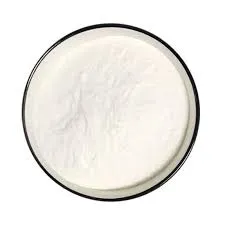
ಡಿಸೆ . 12, 2024 11:09 Back to list
hpmc-hydroxypropyl methyl cellulose manufacturer
HPMC The Versatile Hydroxypropyl Methyl Cellulose and Its Manufacturing Process
Hydroxypropyl Methyl Cellulose (HPMC) is a widely used cellulose derivative that has gained significant attention across various industries, including pharmaceuticals, food, construction, and cosmetics. As a non-ionic, water-soluble polymer, HPMC plays a crucial role in improving the physical characteristics of products, enhancing their stability, and facilitating their application processes. This article delves into the importance of HPMC, its manufacturing process, and the various applications that benefit from its unique properties.
What is HPMC?
HPMC is synthesized from natural cellulose, which is derived from wood pulp or cotton. The process involves etherification, where hydroxypropyl and methyl groups are introduced into the cellulose structure, resulting in a modified cellulose that exhibits enhanced solubility in water and organic solvents. Due to its unique chemical structure, HPMC possesses a variety of functional properties, including thickening, binding, film-forming, and emulsifying capabilities. Its excellent performance under different pH levels and temperatures further adds to its versatility, making it an essential ingredient across various sectors.
Manufacturing Process of HPMC
The manufacturing process of HPMC typically involves several key steps, which ensure the final product meets the desired specifications for purity, viscosity, and other essential properties. Here’s a brief overview of the standard manufacturing procedures
1. Raw Material Selection The process begins with the careful selection of high-quality cellulose as the primary raw material. This cellulose can come from natural sources like wood pulp or cotton, ensuring that it is free from impurities that may impact the final product.
2. Alkalization The selected cellulose is then subjected to an alkalization process. This step is crucial, as it involves treating the cellulose with an alkaline agent (commonly sodium hydroxide) to prepare it for etherification. The alkaline environment swells the cellulose fibers, enhancing the reaction efficiency.
3. Etherification After alkalization, the cellulose undergoes etherification, where it reacts with a mixture of propylene oxide and methyl chloride. This chemical reaction introduces hydroxypropyl and methyl groups into the cellulose structure, resulting in the formation of HPMC. The degree of substitution (the extent to which the cellulose is modified) can be controlled, allowing manufacturers to produce HPMC with varying properties.
hpmc-hydroxypropyl methyl cellulose manufacturer

4. Purification Once the etherification process is complete, the HPMC product is purified to remove any unreacted materials and by-products. This may involve washing, centrifugation, or filtration to ensure that the final product is of high purity and free from contaminants.
5. Drying and Milling The purified HPMC is then dried to reduce its moisture content, which is crucial for ensuring shelf stability. After drying, the product is milled into a fine powder, which increases its surface area and facilitates easier handling and mixing in end applications.
6. Quality Control The final stage involves rigorous quality control testing to ensure that the HPMC meets specific industry standards. This includes checking for viscosity, particle size, moisture content, and other critical parameters to guarantee consistency and performance.
Applications of HPMC
HPMC's adaptability makes it suitable for a wide range of applications. In the pharmaceutical industry, it is commonly used as a thickening agent in ointments, a binder in tablet formulations, and a film-former in coatings. In the food sector, HPMC is utilized as a suitable thickening agent, emulsifier, and stabilizer in various products, including sauces, dressings, and baked goods.
In construction, HPMC is employed in mortars, adhesives, and tile grouts, where it enhances their workability and water retention. In personal care products, it serves as a thickener and stabilizer in lotions, shampoos, and other cosmetics.
Conclusion
As a versatile and functional ingredient, HPMC has solidified its status as a vital component across numerous industries. Understanding its manufacturing process not only highlights the science behind its formulation but also emphasizes its importance in enhancing product quality and performance. As demand for HPMC continues to grow, manufacturers are dedicated to optimizing its production to meet the evolving needs of various sectors, ensuring that HPMC remains a powerhouse of functionality.
-
Versatile Hpmc Uses in Different Industries
NewsJun.19,2025
-
Redispersible Powder's Role in Enhancing Durability of Construction Products
NewsJun.19,2025
-
Hydroxyethyl Cellulose Applications Driving Green Industrial Processes
NewsJun.19,2025
-
Exploring Different Redispersible Polymer Powder
NewsJun.19,2025
-
Choosing the Right Mortar Bonding Agent
NewsJun.19,2025
-
Applications and Significance of China Hpmc in Modern Industries
NewsJun.19,2025







